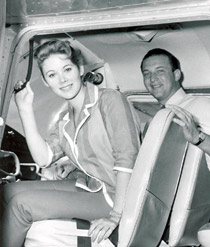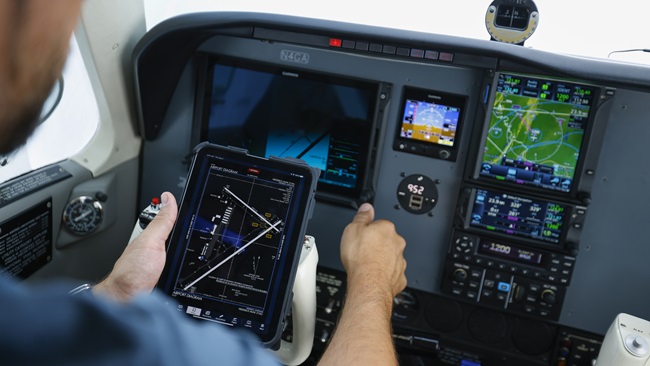 Dark clouds had been gathering when AOPA was founded in May 1939. World War II began only four months later when Germany invaded Poland. These were challenging times for private aviation, as general aviation was then called. For reasons of national security, small airplanes were banned from flying within United States coastal regions. The production of light aircraft ground to a halt as manufacturers concentrated on building machines of war. The concerns and needs of the private pilot paled in comparison to the greater needs of the country.
Dark clouds had been gathering when AOPA was founded in May 1939. World War II began only four months later when Germany invaded Poland. These were challenging times for private aviation, as general aviation was then called. For reasons of national security, small airplanes were banned from flying within United States coastal regions. The production of light aircraft ground to a halt as manufacturers concentrated on building machines of war. The concerns and needs of the private pilot paled in comparison to the greater needs of the country.
It is fortunate that AOPA had been up and running when the war ended. Our collective voices needed to be heard as general aviation began an era of unprecedented expansion. Civil aviation benefitted from the technological progress made during the war, and made rapid transition from taildragging, fabric-covered biplanes to all-metal, closed-cabin monoplanes. Airframe manufacturers were gearing up to take advantage of returning military pilots who surely would want to fly airplanes of their own. It was said with unbridled optimism that there would be a flying machine in every garage.
The postwar flying boom did not materialize, although there were three decades of expansion leading to the 1970s, which is when GA manufacturing peaked. AOPA played an invaluable role in protecting the rights of pilots—rights that otherwise would have been violated and trampled upon as FAA sympathies began to lean increasingly more toward the needs of the airlines. An AOPA membership card in our wallet showed a willingness to collectively fight for these rights.
June 23, 1954, was a big day for me. It was when I turned 16, got my driver’s license, made my first solo flight, and joined AOPA. Although I had never been much of a joiner, belonging to a national organization of pilots seemed cool. Besides, I liked the look of the membership card, and the dues were only a few bucks a year. Also, my subscription issue of Flying magazine contained special, inserted AOPA pages and (secret?) information that only members received. It felt sort of like sending in an Ovaltine label and a quarter to get a Captain Midnight decoder (I still have mine).
AOPA Pilot was not introduced as an independent magazine until March 1958. Max Karant was its first editor, and I had the privilege of writing my first magazine article under his tutelage five years later. I have written for all of AOPA Pilot’s editors over a period of 51 years. I am grateful to them for keeping me aboard. Surprising to me, however, is that a membership consisting of so many who know so much more than I do about flying airplanes would be interested in what I have to say.
In my first few decades with AOPA Pilot, I wrote mostly about proficiency, techniques, and procedures. I enjoyed attempting to destroy myths and develop new attitudes and methods regarding old ideas, still a frequent focus of my monthly columns. In recent years, the emphasis of my feature articles has shifted to writing about fascinating aircraft, particularly those of historical significance, aircraft that help us to better appreciate our aeronautical roots (and give me an opportunity to fly airplanes about which I could otherwise only dream).
One of my most enjoyable roles with AOPA Pilot, though, has been researching and preparing (occasionally with reader assistance) for 20 years the questions and answers in the monthly quiz, “Test Pilot.” Thus far, there have been 3,077 of them.
AOPA’s primary purpose has been to protect and enhance the rights of pilots and aircraft owners. I have not always agreed, however, with association policies. For example, when the “omnirange” (VOR) had been introduced and was replacing the low-frequency range, the FAA’s predecessor, the Civil Aeronautics Administration, wanted to require light airplanes to be equipped with these new navigation systems. I opposed AOPA when it fought in its then-Libertarian style to protect aircraft owners from the expense of such a “Draconian requirement.”
 It disturbs me that there are many GA pilots who do not join us in supporting AOPA and increasing its effectiveness. Such pilots seem to be those who complain the most vociferously about increasing regulation and airports threatened with closure. By not participating in our incessant battle to ensure the healthy survival of GA, they become part of the problem. Working to save airports, developing positive legislation, and lobbying for our interests require increasingly more manpower and greater funding. Those who deprive us of their voices and membership dollars ride the shirttails of others and selfishly force the rest of us to carry the load. Thankfully, such pilots are in the minority. I shudder to think what general aviation would be like today without AOPA. It would not be pretty.
It disturbs me that there are many GA pilots who do not join us in supporting AOPA and increasing its effectiveness. Such pilots seem to be those who complain the most vociferously about increasing regulation and airports threatened with closure. By not participating in our incessant battle to ensure the healthy survival of GA, they become part of the problem. Working to save airports, developing positive legislation, and lobbying for our interests require increasingly more manpower and greater funding. Those who deprive us of their voices and membership dollars ride the shirttails of others and selfishly force the rest of us to carry the load. Thankfully, such pilots are in the minority. I shudder to think what general aviation would be like today without AOPA. It would not be pretty.
Barry Schiff began flying in 1952 and started writing for AOPA Pilot in 1963. He is shown here with his flight student, actress Jill St. John.
Web: www.barryschiff.com



